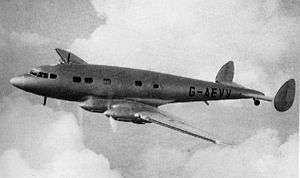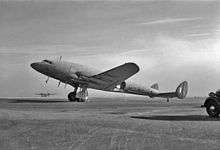de Havilland Albatross
| DH.91 Albatross | |
|---|---|
 | |
| The prototype DH.91 Albatross, G-AEVV, over Hatfield, September 1938 (photo from Flight International) | |
| Role | Mail plane and transport aircraft |
| Manufacturer | de Havilland |
| Designer | A. E. Hagg |
| First flight | 20 May 1937 |
| Introduction | October 1938 |
| Retired | 1943 |
| Primary users | Imperial Airways/British Overseas Airways Corporation Royal Air Force |
| Number built | 7 (including two prototypes) |
|
| |
The de Havilland DH.91 Albatross was a four-engine British transport aircraft in the 1930s. A total of seven aircraft were built in 1938–39.
Development
The DH.91 was designed in 1936 by A. E. Hagg to Air Ministry specification 36/35 for a transatlantic mail plane.
The aircraft was remarkable for the ply-balsa-ply sandwich construction of its fuselage, which was later made famous in the de Havilland Mosquito bomber. Another unique feature was a cooling system for the air-cooled engines that allowed nearly ideal streamlining of the engine mounting.[1] The first Albatross flew on May 20, 1937. The second prototype broke in two during overload tests but was repaired with minor reinforcement, and it and the first prototype were operated by Imperial Airways.
Although designed as a mailplane, a version to carry 22 passengers was developed; the main differences being extra windows and the replacement of split flaps with slotted flaps. Five examples formed the production order delivered in 1938/1939. When war was declared all seven aircraft were operating from Bristol/Whitchurch to Lisbon and Shannon.[2]
Operational history

As normal for the Imperial Airways fleet of the time, all were given names starting with the same letter, and the first aircraft's name was also used as a generic description for the type overall, as "Frobisher Class". This tradition, which came from a maritime and railway background of classes of ships and locomotives, lasted well into postwar days with BOAC and BEA.
The first delivery to Imperial Airways was the 22-passenger DH.91 Frobisher in October 1938. The five passenger-carrying aircraft were operated on routes from Croydon to Paris, Brussels and Zurich. After test flying was completed, the two prototypes were delivered to Imperial Airways as long-range mail carriers. The only significant season of their operation was the summer of 1939, when they were the main type on the two-hourly London Croydon-to-Paris Le Bourget passenger route.
With the onset of World War II, the Royal Air Force considered their range and speed useful for courier flights between Great Britain and Iceland, and the two mail planes were pressed into service with 271 Squadron in September 1940, operating between Prestwick and Reykjavik but both were destroyed in landing accidents in Reykjavík within the space of 18 months: Faraday in 1941 and Franklin in 1942.[3]
The five passenger aircraft were used by Imperial Airways, (BOAC from September 1940) on Bristol–Lisbon and Bristol–Shannon routes from Bristol (Whitchurch) Airport.[3]
One aircraft (Frobisher) was destroyed during a German air raid on Bristol in 1940,[lower-alpha 1] one (Fingal) was destroyed in a crash landing following a fuel pipe failure in 1940 at Pucklechurch, another (Frobisher) was destroyed in an air raid on Whitchurch, and one more (Fortuna) crashed near Shannon Airport in 1943.
This accident was found to be due to deterioration of the aircraft's plywood wing structures. In view of the two surviving aircraft's vulnerability to similar problems, and for lack of spares parts, Falcon and Fiona were scrapped in September 1943.[5]
Aircraft
Faraday
- Mail-carrier variant was delivered to Imperial Airways in August 1939 as Faraday and registered G-AEVV. It was transferred to BOAC when it was formed in 1940 but was impressed into Royal Air Force service with serial number AX903 for operation by No. 271 Squadron RAF. It was destroyed in a landing accident at Reykjavik on the 11 August 1941.[6][7]
Franklin
- Mail-carrier variant was delivered to BOAC as Franklin and registered G-AEVW. Impressed into Royal Air Force Service with the serial number AX904 for operation by 271 Squadron. It was destroyed when the landing gear collapsed on landing at Reykjavik on the 7 April 1942.[6][8]
Frobisher
- Passenger variant was registered G-AFDI and delivered to Imperial Airways (later BOAC) as Frobisher in 1938. It was destroyed on the ground during a German air attack on Whitchurch Airport on 20 December 1940.[6][9]
Falcon
- Passenger variant was registered G-AFDJ and delivered to Imperial Airways (later BOAC) as Falcon in 1938. It was scrapped in September 1943.[6][10]
Fortuna
- Passenger variant was registered G-AFDK and delivered to Imperial Airways (later BOAC) as Fortuna in 1939. Destroyed in a crash landing near Shannon Airport, Ireland on 16 July 1943.[6][11]
Fingal
- Passenger variant was registered G-AFDL and delivered to Imperial Airways (later BOAC) as Fingal in 1939. Destroyed in a crash landing near Pucklechurch, Gloucestershire, England on 6 October 1940.[6][12]
Fiona
- Passenger variant was registered G-AFDM and delivered to Imperial Airways (later BOAC) as Fiona in 1939. It was scrapped in September 1943.[6][13]
Operators
- Imperial Airways which was reorganized as British Overseas Airways Corporation received all seven aircraft.
- Royal Air Force
- No. 271 Squadron RAF operated two aircraft taken over from BOAC.
Specifications (DH.91)
Data from British Civil Aircraft since 1919 [14]
General characteristics
- Crew: four (pilot, copilot, radio operator and steward)
- Capacity: 22 passengers
- Length: 71 ft 6 in (21.80 m)
- Wingspan: 105 ft 0 in (32.01 m)
- Height: 22 ft 3 in (6.78 m)
- Wing area: 1,078 ft² (100.2 m²)
- Empty weight: 21,230 lb (9,650 kg)
- Loaded weight: 29,500 lb (13,380 kg)
- Powerplant: 4 × de Havilland Gipsy Twelve 12-cylinder inverted V piston engine, 525 hp (392 kW) each
Performance
- Maximum speed: 195 kn (225 mph, 362 km/h)
- Cruise speed: 183 kn (210 mph, 338 km/h)
- Range: 904 nmi, (1,040 mi, 1,675 km)
- Service ceiling: 17,900 ft (5,455 m)
- Rate of climb: 700 ft/min (3.5 m/s)
- Wing loading: 27 lb/ft² (134 kg/m²)
- Power/mass: 0.07 hp/lb (120 W/kg)
See also
- Related development
- Related lists
References
Notes
Citations
- ↑ "Cooling System for Plane Engines Uses Air Piped from Wings" Popular Science, September 1938, drawing of cooling system
- ↑ Mondey, Dvaid (1982). Hamlyn Concise Guide to British Aircraft of World War II. Hamlyn Publishing Group Ltd. p. 75. ISBN 1851526684.
- 1 2 Moss Air Pictorial, September 1964, p. 292.
- ↑ Moss Air Pictorial September 1964, p. 293.
- ↑ Moss Air Pictorial, September 1964, p. 294.
- 1 2 3 4 5 6 7 Jackson 1973, pp 472
- ↑ Civil Aviation Authority Registration Entry for G-AEVV
- ↑ Civil Aviation Authority Registration Entry for G-AEVW
- ↑ Civil Aviation Authority Registration Entry for G-AFDI
- ↑ Civil Aviation Authority Registration Entry for G-AFDJ
- ↑ Civil Aviation Authority Registration Entry for G-AFDK
- ↑ Civil Aviation Authority Registration Entry for G-AFDL
- ↑ Civil Aviation Authority Registration Entry for G-AFDM
- ↑ Jackson 1973, p.153.
Bibliography
| Wikimedia Commons has media related to De Havilland DH.91 Albatross. |
- Kopenhagen, Wolfgang (editor) (1987). Das große Flugzeug-Typenbuch. Transpress. ISBN 3-344-00162-0.
- Jackson, A. J. (1987). De Havilland aircraft since 1909. Naval Institute Press. ISBN 0-87021-896-4.
- Jackson, A. J. (1973). British Civil Aircraft since 1919, Volume 2 (2nd ed.). Putnam. ISBN 0-370-10010-7.
- Moss, Peter W. (September 1964). "The de Havilland D.H.91 Albatross". Air Pictorial. Vol. 26 no. 9. pp. 292–294.